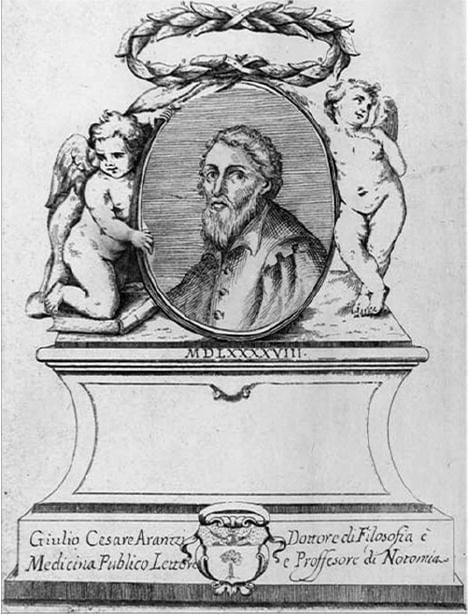
Julius Caesar Aranzi (Aranzio, Arantius) was born in Bologna in 1529 or 1530. As a young man he received a good education even though he hailed from a poor family. He studied under the supervision of his uncle Bartolomeo Maggi, an outstanding surgeon and at one time principal court physician to the Pope. Admitted to the University of Padua at age nineteen, Aranzi received a doctorate in medicine from the University of Bologna in 1556 and was appointed their lecturer in anatomy and surgery. In 1570 he arranged to have the University of Bologna chairs of anatomy and surgery separated but held both positions until his death in 1589. He achieved prominence in both anatomy and surgery, receiving the highest salary at the University, and conducting a successful private surgical practice. He treated the members of the aristocracy and senate of Bologna and their families and published widely on surgical subjects such as treating gunshot wounds, tumors, and ulcers. He also wrote on the treatment of hydrocephalus, nasal polyps, goiter, phimosis, ascites, hemorrhoids, rectal abscesses, and fistulae.
Aranzi made his first contribution to anatomy at the age of nineteen when he described the elevator muscle of the upper eyelid. He described the coracobrachialis muscle, the “nodules of Aranzio” in the valves of the heart, the ductus arteriosus and ductus venosus in the fetal circulation, and the cavities of the heart and the great vessels. He agreed with Realdo Colombo that the blood circulated from the right side of the heart the left. Neurologists remember him for describing the hippocampus, the ventricles and their cornua, the choroid plexus, and for establishing that the muscles of the eye were attached to the optic hole in the orbit and not to the dura mater. He illustrated the anatomy of the fetus, studied uterine constriction, dissected the dead bodies of pregnant women with his students, and also proved that during pregnancy the blood circulations of the mother and fetus remain separate.
Aranzi is also remembered as the teacher of Gaspare Tagliacozzi, now acknowledged as the father of plastic surgery and nasal reconstruction, and whom Aranzi taught some of his techniques. According to tradition, nasal reconstruction was first carried out around 500 BC by the Indian surgeon Sushruta, much later by the German barber-surgeon Pfoslpeundt (1460), and as a trade secret by the Branca families in Sicily and the Bojanos and the Vineos in Calabria. The technique was described and popularized in a book written in 1570 by the barber-surgeon Leonardo Fioravanti, which may have served as inspiration to the Bologna surgeons.
Aranzi died in 1589. He was beloved and esteemed by his students, a conscientious investigator who made important contributions to the discipline of anatomy and to the reputation of the medical school of the University of Bologna.

Leave a Reply